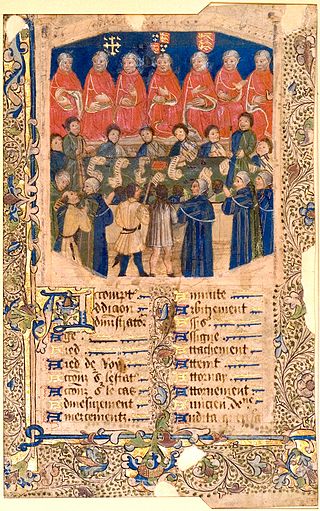Related Research Articles

Sir Charles Edward Pollock was an English judge, one of the last Barons of the Court of the Exchequer and serjeants-at-law.
Nisi prius is a historical term in English law. In the 19th century, it came to be used to denote generally all legal actions tried before judges of the King's Bench Division and in the early twentieth century for actions tried at assize by a judge given a commission. Used in that way, the term has had no currency since the abolition of assizes in 1971.
Plea rolls are parchment rolls recording details of legal suits or actions in a court of law in England.

The Court of Common Pleas, or Common Bench, was a common law court in the English legal system that covered "common pleas"; actions between subject and subject, which did not concern the king. Created in the late 12th to early 13th century after splitting from the Exchequer of Pleas, the Common Pleas served as one of the central English courts for around 600 years. Authorised by Magna Carta to sit in a fixed location, the Common Pleas sat in Westminster Hall for its entire existence, joined by the Exchequer of Pleas and Court of King's Bench.
Nominate reports, also known as nominative reports, named reports and private reports, is a legal term from common-law jurisdictions referring to the various published collections of reports of English cases in various courts from the Middle Ages to the 1860s, when law reporting was officially taken over by the Incorporated Council of Law Reporting, for example Edmund F. Moore's Reports of Cases Heard and Determined by the Judicial Committee and the Lords of His Majesty's most Honourable Privy Council on Appeal from the Supreme and Sudder Dewanny Courts in the East Indies published in London from 1837 to 1873, referred to as Moore's Indian Appeals and cited for example as: Moofti Mohummud Ubdoollah v. Baboo Mootechund 1 M.I.A. 383.

Sir Edward Ryan PC FRS was an English lawyer, judge, reformer of the British Civil Service and patron of science. He served as Chief Justice of Bengal from 1833–43.
James Manning (1781–1866) was an English barrister, serjeant-at-law and law writer.
Charles Erdman Petersdorff was a legal writer.
Francis Ludlow Holt was a legal and dramatic author.

The Act 7 Will. 4 & 1 Vict. c. 85, sometimes called the Offences against the Person Act 1837, was an Act of the Parliament of the United Kingdom of Great Britain and Ireland. It amended the law relating to offences against the person. It was one of the Acts for the Mitigation of the Criminal Law passed during the session 7 Will. 4 & 1 Vict. The Legal Observer said that this Act materially lessened the severity of the punishment of offences against the person.
The hobbit is a unit of volume or weight formerly used in Wales for trade in grain and other staples. It was equal to two and a half bushels, but was also often used as a unit of weight, which varied depending on the material being measured. The hobbit remained in customary use in markets in northern Wales after Parliament standardized the Winchester bushel as the unit of measure for grain, after which courts gave inconsistent rulings as to its legal status.

The courts of assize, or assizes, were periodic courts held around England and Wales until 1972, when together with the quarter sessions they were abolished by the Courts Act 1971 and replaced by a single permanent Crown Court. The assizes exercised both civil and criminal jurisdiction, though most of their work was on the criminal side. The assizes heard the most serious cases, most notably those subject to capital punishment or later life imprisonment. Other serious cases were dealt with by the quarter sessions, while the more minor offences were dealt with summarily by justices of the peace in petty sessions.

The High Court of Justice in London, known properly as His Majesty's High Court of Justice in England, together with the Court of Appeal and the Crown Court, are the Senior Courts of England and Wales. Its name is abbreviated as EWHC for legal citation purposes.
Espinasse's Reports, formally titled Reports of Cases argued and ruled at Nisi Prius, in the Courts of King's Bench and Common Pleas, from E. T., 33 Geo. III, to T. T. 47 Geo. III, is a collection of nominate reports by Isaac Espinasse, of nisi prius cases decided between 1793 and 1807. They are in six volumes. They may be cited as "Esp.".

The Assessed Taxes Act 1840 is an Act of Parliament passed in Victorian England. The abridgement of the Act is shown dated 29 July 1839; the previous Act expired on 5 April the following year. The Act was amended again in 1841, 1845, 1851 and 1854.
The Court of Pleas of the County Palatine of Durham and Sadberge, sometimes called the Court of Pleas or Common Pleas of or at Durham was a court of common pleas that exercised jurisdiction within the County Palatine of Durham until its jurisdiction was transferred to the High Court by the Supreme Court of Judicature Act 1873. Before the transfer of its jurisdiction, this tribunal was next in importance to the Chancery of Durham. The Court of Pleas probably developed from the free court of the Bishop of Durham. The Court of Pleas was clearly visible as a distinct court, separate from the Chancery, in the thirteenth century.
The Court of Common Pleas of the County Palatine of Lancaster, sometimes called the Common Pleas of or at Lancaster was a court of common pleas that exercised jurisdiction within the County Palatine of Lancaster until its jurisdiction was transferred to the High Court by the Supreme Court of Judicature Act 1873. It was a Superior Court of Record, exercising, within the limits of the County Palatine, a jurisdiction similar to that of the superior courts of common law at Westminster.
Reliance was built in France in 1790 and was registered in 1804 at Bristol. She left Bristol on a voyage as a slave ship but her crew scuttled her in June before having embarked any slaves.

The Pennsylvania High Court of Errors and Appeals was a public tribunal existing from 1780 to 1808; it was the court of last resort in the Commonwealth. The Pennsylvania General Assembly created it during the American Revolution to take the place of the British Appeals Committee of the Privy Council. The High Court heard cases from the Supreme Court of Pennsylvania and other lower state courts. Eventually the General Assembly voted to abolish the High Court, effective in 1808, and transfer its powers to the state supreme court.

Mellor v Spateman (1669) 1 Wm. Saund. 339, is an English common law trespass case heard in the Court of King's Bench where it was held that a corporation may prescribe to have a common of pasture. In relation to cattle levant and couchant within the town, a corporation may prescribe for common in gross, but not for common in gross without number.
References
- Carrington and Payne. Reports of Cases argued and ruled at Nisi Prius, in the Courts of King's Bench and Common Pleas, and on the Circuit; from the Sittings in Michaelmas Term, 1823, to the Sittings after Hilary Term, 1825. S Sweet. London. 1825. Volume I. Digitized copy from Google Books.
- Carrington and Payne. Reports of Cases argued and ruled at Nisi Prius, in the Courts of King's Bench and Common Pleas, and on the Circuit; from the Sittings in Easter Term, 1825, to the Sittings in Trinity Term, 1827. S Sweet. London. 1827. Volume II. Digitized copy from Google Books.
- Carrington and Payne. Reports of Cases argued and ruled at Nisi Prius, in the Courts of King's Bench and Common Pleas, and on the Circuit; From the Sittings after Trinity Term, 1827, to the Sittings after Easter Term, 1829. Volume III. S Sweet. London. R Milliken & Son. Dublin. 1829. Digitized copy from Google Books.
- Carrington and Payne. Reports of Cases argued and ruled at Nisi Prius, in the Courts of King's Bench, Common Pleas, & Exchequer; together with Cases tried on the Circuits & at the Old Bailey; from the Sittings after Trinity Term, 1831, to the Sittings after Hilary Term, 1833. Volume V. S Sweet. London. R Miliken and Son. 1833. Digitized copy from Google Books.
- Volume VI. Snippet view from Google Books.
- Carrington and Payne. Reports of Cases argued and ruled at Nisi Prius, in the Courts of King's Bench, Common Pleas, & Exchequer; together with Cases tried on the Circuits, and in the Central Criminal Court: From Hilary Term, 5 Will. IV., to Easter Term, 7 Will. IV. Volume VII. S Sweet. London. R Milliken & Son. Dublin. 1837. Digitized copy from Google Books.
- Carrington and Payne. Reports of Cases argued and ruled at Nisi Prius, in the Courts of King's Bench, Common Pleas, & Exchequer; together with Cases tried on the Circuits, and in the Central Criminal Court: From Hilary Term, 7 Will. IV., to Easter Term, 2 Vict. Volume VIII. S Sweet. London. R Milliken and Son. Dublin. 1839. Digitized copy from Google Books.
- Carrington and Payne. Reports of Cases argued and ruled at Nisi Prius, in the Courts of King's Bench, Common Pleas, & Exchequer; together with Cases tried on the Circuits, and in the Central Criminal Court: From Easter Term, 2 Vict., to Easter Term, 4 Vict. S Sweet. London. A Milliken. Dublin. 1841. Digitized copy from Google Books.
- ↑ Marvin, J.G. Legal Bibliography, or a thesaurus of American, English, Irish and Scotch law books:together with some continental treatises. T & J W Johnson. 1847. Page 175, from Google Books.
- 1 2 3 Index Chart issued for the English Reports, 1930, Stevens & Sons Ltd. (London), W. Green & Son, Ltd. (Edinburgh). Page 6.
- 1 2 Marvin, J.G. Legal Bibliography, or a thesaurus of American, English, Irish and Scotch law books:together with some continental treatises. T & J W Johnson. 1847. Page 175
- ↑ K G Saur Books. Guide to Microforms in Print 2006: Author, Title. K. G. Saur Verlag GmbH. Revised Edition. 2006. ISBN 9783598117121. Volume 1. Page 417. Google Books.
- ↑ Guide to Microforms in Print 2006: Author, Title. K. G. Saur Verlag GmbH. 2006. ISBN 9783598117121. Page 417.
- ↑ "CaseBase Case Citator Abbreviations". LexisNexis . Retrieved 21 March 2013.
- ↑ "Joel v Morison" (PDF). BAILII . CommonLII . Retrieved 21 March 2013.